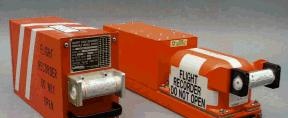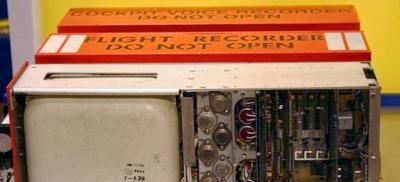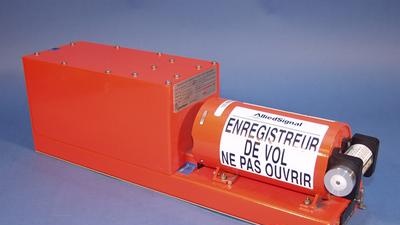|
 This mysterious box is most often mentioned on the radio or in newspapers in connection with plane crashes or accidents. At the same time, they not only cite the number of accidents and search hot on the trail of the cause of the incident, but also necessarily raise the question of whether it was possible to find the "black box". This mysterious box is most often mentioned on the radio or in newspapers in connection with plane crashes or accidents. At the same time, they not only cite the number of accidents and search hot on the trail of the cause of the incident, but also necessarily raise the question of whether it was possible to find the "black box".
After all, it contains the answers to the most important questions, and without his objective help it is difficult for the competent commission to make a final decision.
What is the secret of the "black box"? This is a device that records the course of the flight, a flight recorder. A number of data is systematically recorded on a magnetic tape (sometimes their number reaches several dozen). The recorder is equipped with a protective casing that protects it from destruction during a disaster. It used to be painted black. Hence the name - "black box". In fact, it is by no means black, but yellow or bright orange, so that it can be easily noticed.
Devices of this type appeared in aviation in the thirties. The aircraft designers were interested in how the vibrations of individual parts of the wings and fuselage proceed and what the accelerations are during flight. This is where it all started. A smoked glass roller was used as a recording device, on which a lead scratched a recording line. Over time, new methods of registration have appeared, the range of information to be recorded has expanded. It was carried out on special tapes covered with chalk or soot, on illuminated film or film. Then, using burning or perforation, the data was transferred to paper tapes. Both a beam of light falling on a photosensitive film and a photograph were used: the readings of the instruments installed in the cockpit were recorded by a camera - with an interval of several seconds. Magnetic recording, mainly on magnetic tape, has been a great achievement. This made it possible, on the one hand, to increase the number of indicators to several tens and even hundreds, and on the other, to sharply reduce the size and weight of the recorders.
 So, thanks to the recording devices, the designers, and later the operators, were able to obtain important information about what is happening in the air with individual parts and components of the machine, and how it reacts to changes in flight conditions. So, thanks to the recording devices, the designers, and later the operators, were able to obtain important information about what is happening in the air with individual parts and components of the machine, and how it reacts to changes in flight conditions.
The analysis of the data obtained allowed the designers to recognize the shortcomings in individual details in a timely manner and introduce the necessary improvements. In tried and tested aircraft, the information provided by the recorder served to verify the safety of the flight and helped to identify specific damage or defects. This is how the idea of using "black boxes" on passenger planes came about.
The flight recording device consists of two parts. The main part, containing the drive and recording mechanisms, as well as the magnetic tape, is in the form of a ball or cylinder. It is protected from high temperatures by a special heat-resistant layer, and from dents and impacts - by a massive inner covering made of durable material. The second part, which houses the electronic device, is a rectangular box. It has no protective housing, so it can be destroyed in an accident. Magnetic tape is usually made of metal or terylene, about 30 mm thick, 0.5 inches wide, and several tens of meters long. It is designed for several hours of work. The number of tracks ranges from four to sixteen. The tape is rewound back and forth from one reel to another. Switching tracks occurs automatically depending on the change in the direction of winding the tape.
The "black box" (on-board recording device) receives dozens of different data from the aircraft dashboard, which is monitored by the crew members, and from individual sensors installed in the most vulnerable points of the vehicle. Their signals, usually in the form of electrical impulses (voltages), are converted by the electronic devices of the recorder. This includes numerous integrated printed circuits. The newest recorders are equipped with automatic check circuits to determine the correct functioning of the equipment. As a rule, the "black box" has the following dimensions: 497 mm x 194 mm x 124 mm, and its weight reaches 15 kg.
 The recorded information is stored in it for 24 hours of the aircraft's operation from the moment the engines start to stop. In accordance with international standards, data such as speed and duration of flight, magnetic heading and vertical g-forces are recorded without fail. In addition, the roll is recorded; sliding angle on the wing; position of navigation devices; effort applied to pedals and control rod; positions of flaps, aerodynamic brakes and other moving parts of the aircraft; thrust or engine power; the angle of attack of the wings; fuel consumption; ambient temperature; turning the autopilot on and off, etc. Data is recorded at a frequency of 1-8 times per second. After 25 hours, the recording is automatically erased. The data stored in the recorder's memory helps to understand the causes of all kinds of accidents. The recorded information is stored in it for 24 hours of the aircraft's operation from the moment the engines start to stop. In accordance with international standards, data such as speed and duration of flight, magnetic heading and vertical g-forces are recorded without fail. In addition, the roll is recorded; sliding angle on the wing; position of navigation devices; effort applied to pedals and control rod; positions of flaps, aerodynamic brakes and other moving parts of the aircraft; thrust or engine power; the angle of attack of the wings; fuel consumption; ambient temperature; turning the autopilot on and off, etc. Data is recorded at a frequency of 1-8 times per second. After 25 hours, the recording is automatically erased. The data stored in the recorder's memory helps to understand the causes of all kinds of accidents.
In addition to the recording device, a tape recorder is installed in the cockpit. The BUR records all sounds in the cockpit. The recording is calculated for half an hour. Previous entries are automatically erased. Thus, at any time, you can restore everything that happened in the cockpit during the last thirty minutes of the flight.
Recording devices are an obligatory and integral part of the equipment of modern passenger and cargo aircraft. Black boxes are increasingly being used on helicopters, agricultural and military aircraft.
The "Black Box" was invented by the Englishman Alfred Weston. He owns a patent not only for this, but also for a number of other inventions in the field of aircraft technology.
E. Domansky
Read now
All recipes
|
 This mysterious box is most often mentioned on the radio or in newspapers in connection with plane crashes or accidents. At the same time, they not only cite the number of accidents and search hot on the trail of the cause of the incident, but also necessarily raise the question of whether it was possible to find the "black box".
This mysterious box is most often mentioned on the radio or in newspapers in connection with plane crashes or accidents. At the same time, they not only cite the number of accidents and search hot on the trail of the cause of the incident, but also necessarily raise the question of whether it was possible to find the "black box". So, thanks to the recording devices, the designers, and later the operators, were able to obtain important information about what is happening in the air with individual parts and components of the machine, and how it reacts to changes in flight conditions.
So, thanks to the recording devices, the designers, and later the operators, were able to obtain important information about what is happening in the air with individual parts and components of the machine, and how it reacts to changes in flight conditions. The recorded information is stored in it for 24 hours of the aircraft's operation from the moment the engines start to stop. In accordance with international standards, data such as speed and duration of flight, magnetic heading and vertical g-forces are recorded without fail. In addition, the roll is recorded; sliding angle on the wing; position of navigation devices; effort applied to pedals and control rod; positions of flaps, aerodynamic brakes and other moving parts of the aircraft; thrust or engine power; the angle of attack of the wings; fuel consumption; ambient temperature; turning the autopilot on and off, etc. Data is recorded at a frequency of 1-8 times per second. After 25 hours, the recording is automatically erased. The data stored in the recorder's memory helps to understand the causes of all kinds of accidents.
The recorded information is stored in it for 24 hours of the aircraft's operation from the moment the engines start to stop. In accordance with international standards, data such as speed and duration of flight, magnetic heading and vertical g-forces are recorded without fail. In addition, the roll is recorded; sliding angle on the wing; position of navigation devices; effort applied to pedals and control rod; positions of flaps, aerodynamic brakes and other moving parts of the aircraft; thrust or engine power; the angle of attack of the wings; fuel consumption; ambient temperature; turning the autopilot on and off, etc. Data is recorded at a frequency of 1-8 times per second. After 25 hours, the recording is automatically erased. The data stored in the recorder's memory helps to understand the causes of all kinds of accidents.





